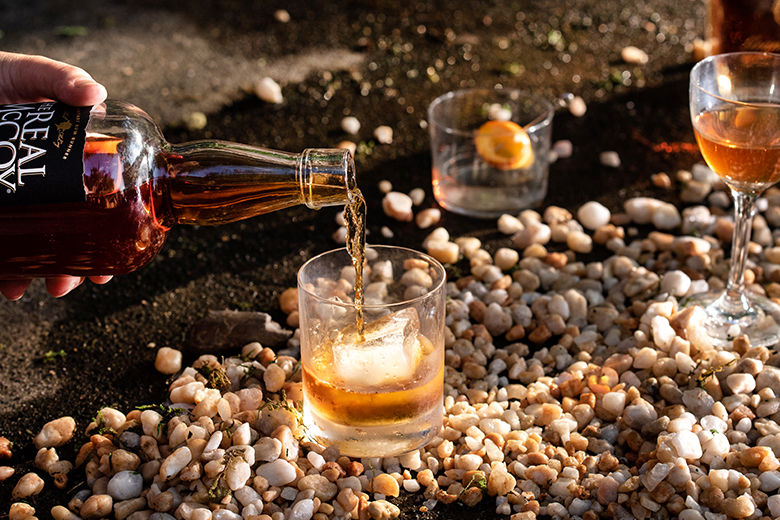
As I walked up toward Foursquare Distillery in Barbados this past March, I noted the unmissable proclamation on the side of one of its many buildings: “We are an environmentally friendly facility, and proud of it!” It’s quite the statement, and immediately I wondered how; distillation is a notoriously wasteful venture, especially regarding water waste. Just a month prior, I’d visited Destilería Serrallés in Ponce, Puerto Rico, where rum-maker Roberto Serrallés has been open about their efforts to create an eco-friendly process and the places in which they inevitably fall short (despite attempts at a perfect closed-loop system, greenhouse gases always want to escape). Both operations are major, though, making any effort meaningful—and challenging.
For Foursquare, located on an island with water scarcity issues, modern awareness of the environmental issues endemic to the creation of their spirits dates back to 1996. To cut water waste, there is an aeration system in place that goes toward irrigating the sugarcane and vegetable crops around the distillery. “This water processing allows Foursquare to balance the pH of our process water, and thus safely reuse the water and not pump it into the sea in an untreated and highly acidic state, where it could otherwise damage the marine ecosystem,” says Bailey Pryor, founder of the Real McCoy rums, which are made at Foursquare. “During the distillation process, preheated water is reused to raise process water temperatures for distillation, thus reducing the amount of fuel necessary to create steam for the stills.”
Serrallés treats wastewater with a specialized bacteria that removes 70 percent of organic material that could potentially endanger marine life. When the statistic is that for every bottle of spirit, 10 bottles of wastewater are created in the distillation process, every step toward reducing that number affects the local ecosystems.

When, in May, I visited Casa Herradura in Amatitán, Mexico—where water is also scarce—via a ride on their own train from Guadalajara, I went in with questions about whether producers of this agave-based spirit might be addressing issues I’d seen rum-makers struggling with. Apparently, Herradura was the first tequila producer to develop a wastewater treatment plant that has met requirements for Mexico’s PROFEPA’s Environmental Excellence Award. Additionally, they recycle the gas produced during the treatment process to power portions of the distillation process—similar to what’s done at Foursquare to reduce fuel needs.
All of these efforts would be de rigeur when it comes to the food a chef might want to put on a plate, where sustainability and organic processes have long become a standard for a certain kind of restaurant, but spirits lag behind on this. To see large producers taking matters into their own hands, since small-batch spirits aren’t going to rule the world anytime soon, has been encouraging.
Because Herradura is owned by the massive Brown-Forman, which as a corporation has a goal of reaching zero waste to landfills by 2023, they currently send less than 1 percent of their solid waste—sludge from treatment, other general garbage—to landfills. At Foursquare, spent solids from the mash, an additional nutrient rich by-product of fermentation, are repurposed for fertilizer and animal feed use.

One of the biggest hurdles to creating a sustainable distillery is local sourcing of base product, something Herradura doesn’t face because all blue Weber agave used to make tequila must be grown in the state of Jalisco. Foursquare, too, uses local Barbadian molasses and sugarcane, while Serrallés must import their molasses from the Dominican Republic, but are working to restore Puerto Rico’s sugarcane-growing tradition.
Carbon dioxide use is another big, overarching issue. Pryor notes that at Foursquare, it’s reused. “When molasses is fermented to produce alcohol, carbon dioxide (CO2) is produced as a by-product. This carbon dioxide is captured in closed-top fermenter tanks, then the CO2 is ‘washed,’ purified and liquefied for use in the carbonation of soft drinks on the island,” he says. “Carbon dioxide is one of the ‘greenhouse effect’ gases, therefore by collecting the CO2 we are maintaining our commitment to a clean environment. By capturing CO2 on the island, this further reduces the carbon footprint that would otherwise be generated by shipping liquified CO2 to Barbados for use in beverages.”
Herradura’s use of wild fermentation in their processes is rather surprising for a facility of their size. Sixteen various fruit trees—limes, sour oranges and more—surround the open-air fermentation facility, attracting the proper kind of yeast for their production that they’ve been using for nearly 150 years.
Of course nothing about any large-scale spirits production is going to be perfect. (Nothing about humans living globalized lives on this planet is going to be perfect, in fact.) But these efforts are forward thinking—and their influence will hopefully spread, as knowledge of how detrimental an environmental impact the making of spirits can have, and in so many ways. While we wait for a utopian small-batch future, we can at least sip on these.



